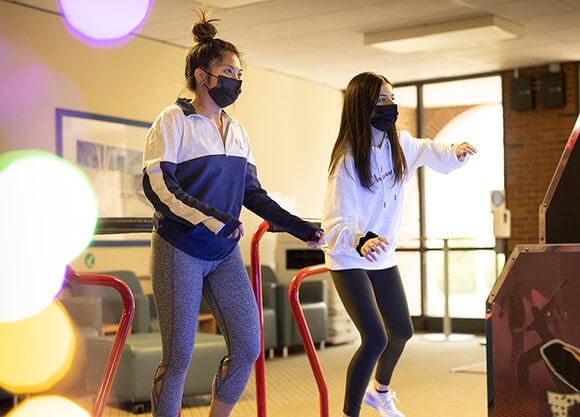
Inaugural Bobcat Day a roaring success
April 22, 2021

April 22, 2021

All across campus Wednesday, thousands of undergraduates marked the first Bobcat Day, a celebration of Quinnipiac’s past, present and future.
Marshall, president of the Student Government Association, brought the day-long event to life with the help of student volunteers and university leaders. The schedule included multicultural speakers, film screenings, a virtual concert, dance workshops, arcade games, prizes and more.
“We’re hoping this ends up being something that becomes an annual tradition, and eventually, something the university will take over,” Marshall said. “It’s a very unique thing that Quinnipiac will have. There are only two or three schools in the nation that do something like this.”
For Tom Ellett, the university’s chief experience officer, it was a day dedicated to rejuvenation, self-care and school spirit. It was a day for Quinnipiac students to come together and have fun, to learn about each other and create a new tradition.
“Today is a day when we will examine the roots of the Bobcat and open our minds to history,” Ellett said. “We will immerse ourselves in art and culture, and my personal favorite, play games against self and against each other.”
Ellett grew up as the youngest of six children in Lansingburgh, New York, near Albany. He was the boy who wore “traditional clothes called hand-me-downs.”
More importantly, Ellett was part of a family bonded by traditions, a family that went bowling on Thanksgiving and sat around an endless table while 21 people played the card game, Hearts. The best players won all the points in a round, a play called shooting the moon.
It was the perfect metaphor for Bobcat Day. Why not shoot the moon? Why not hitch your wagon to a star, as Ralph Waldo Emerson once wrote?
“Traditions are a part of a culture,” President Judy Olian told students in her opening remarks. “You are all firsts. You are starting a tradition that will last decades, I’m sure, and maybe even centuries as we go forward.
“I hope this doesn’t just build deeper roots at Quinnipiac for the students who are here,” she added, “but that you will come back every year to celebrate this great tradition.”
Bobcat Day was a day of hands-on exploration at Quinnipiac, a chance to make tie-dye shirts and ribbons of pasta, all while making new friends and new memories.
And yes, even a new campus tradition.
But it was also a day of social and cultural awareness, an important opportunity to learn about the depth of diversity at Quinnipiac, both past and present
Christina Dickerson, an assistant professor of history, spoke about the Native Americans — the Quinnipiac — who once lived where QU now stands.
“We are on Quinnipiac land right now. We are on their ancestral homeland,” Dickerson said. “We should all acknowledge and recognize that.”
In 1600, Dickerson said, the Quinnipiac lived on about 300 square miles of land that stretched from modern-day New Haven to New Britain. By 1634, deadly epidemics spread by Dutch and English settlers reduced the Quinnipiac population to about 460.
“The English continued to expand in Connecticut, establishing more and more settlements, putting more pressure on the Quinnipiac and other tribes in New England,” Dickerson said.
By 1773, the Quinnipiac sold their last 30 acres of land in New Haven. Over the next 50 years, many of the Quinnipiac migrated to New York, Massachusetts and Wisconsin.
“Some Quinnipiac, however, remained in Connecticut and married into other communities,” Dickerson said. “Because of that, they became invisible to the eyes of the Europeans. They didn’t exist anymore because they had intermarried into these communities.”
The Quinnipiac are not invisible to the university that bears their name. They are remembered and honored, most recently, in the university’s 10-point plan to advance racial justice.
For Kiara Tanta-Quidgeon ’22, founder of the Indigenous Student Union at Quinnipiac, the fatigue to represent an entirely community is real.
“With this position, and being one of the few Native students on campus, there is a lot of pressure and a lot of responsibility and commitment that isn’t as much a choice,” she said. “With more and more internal and external expectations, it’s not a choice to be a leader, create change and educate others.”
Students who represent marginalized communities find the resources use the resources and support offered at Quinnipiac to fight for equity, inclusion and social justice.
A day after former police officer Derek Chauvin was convicted of murdering George Floyd in police custody in 2020, three juniors from the Black Student Union — Toyloy Brown III, Lydia Jones and Ja’Vielle W. Foy — discussed the verdict and the Black Lives Matter movement.
“I didn’t feel any sort of jubilation. I didn’t feel happy,” Brown said. “I thought this is justice.”
For juniors Ali Vidallon and Apple Longo of the Gender Sexuality Alliance, recent changes at Quinnipiac, including gender-inclusive housing and bias training for faculty, staff and student leaders, highlight meaningful progress for the LGBTQ+ community.
But the hard work and heavy lifting isn’t over, said Vidallon, the GSA president.
“When sharing diversity on campus,” she said, “the most highly efficient way to create change is to educate others.”
Just ask Sophia Marshall. Or Tom Ellett.
Making new friends and learning about others is a surefire way to shoot for the moon.
Quinnipiac Today is your source for what's happening throughout #BobcatNation. Sign up for our weekly email newsletter to be among the first to know about news, events and members of our Bobcat family who are making a positive difference in our world.
Sign Up Now